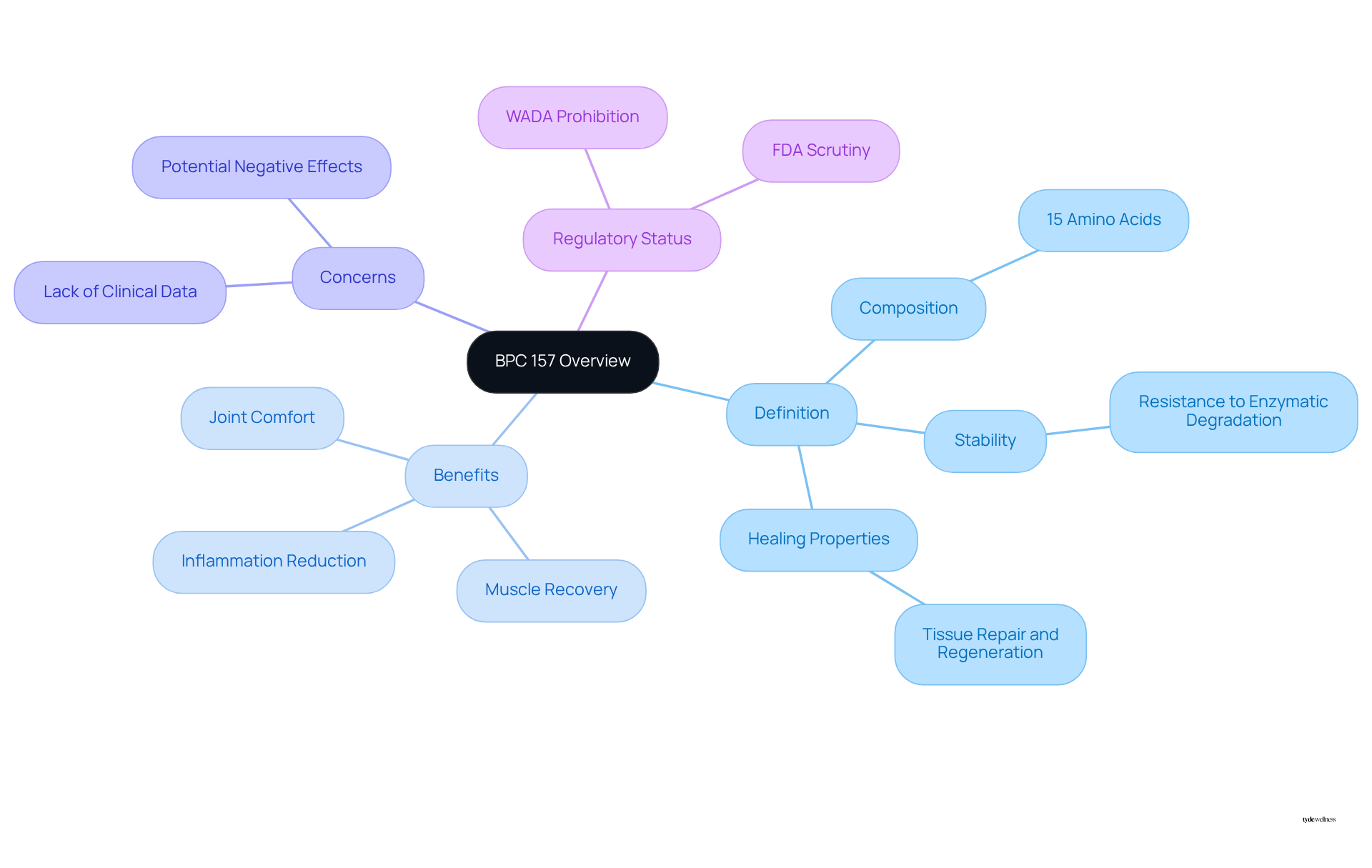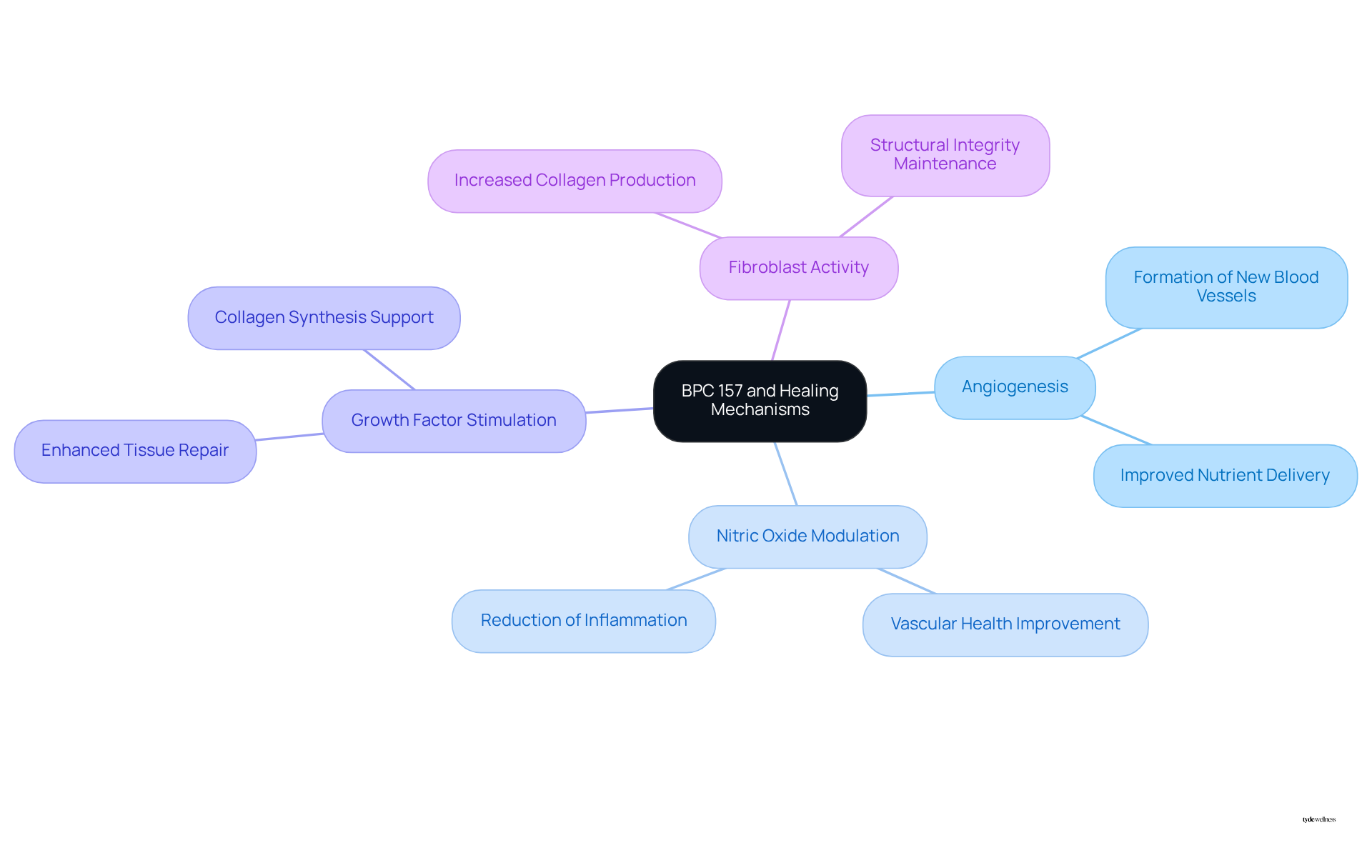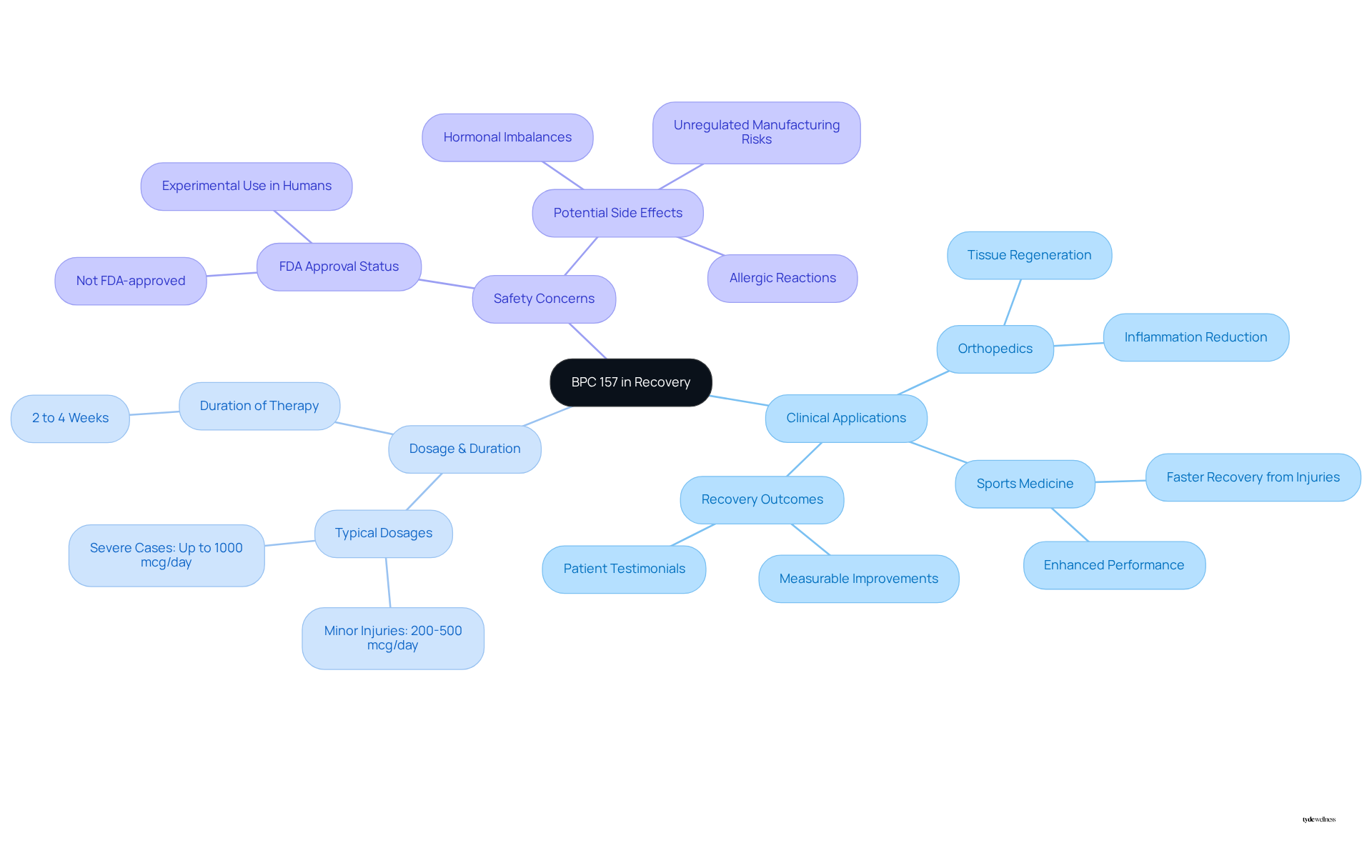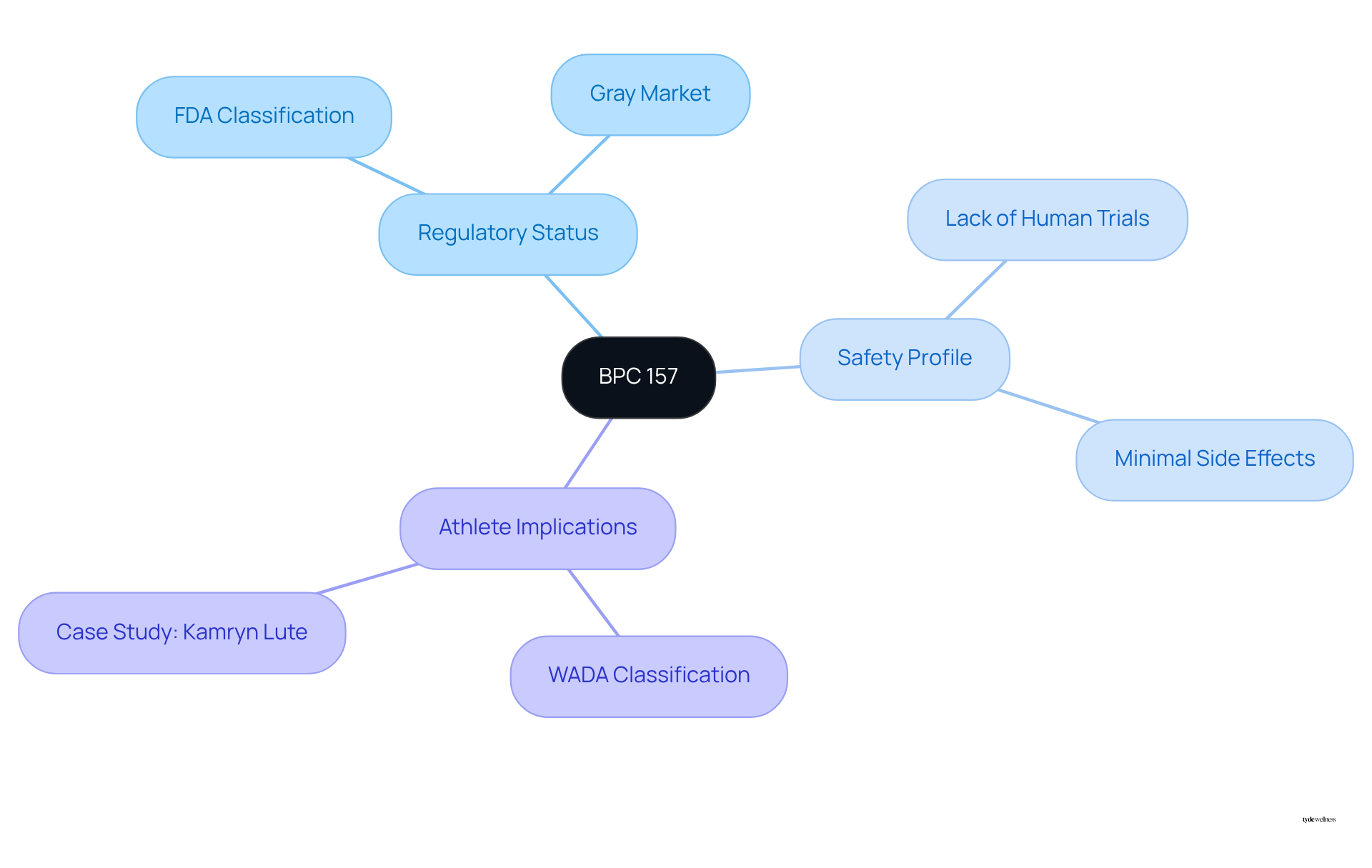Overview
BPC 157 is a synthetic peptide made up of 15 amino acids, which is believed to promote healing through various mechanisms. These include:
- Enhancing angiogenesis
- Reducing inflammation
- Stimulating growth factors that aid tissue repair
Its potential benefits in recovery from injuries, especially within the realm of sports medicine, are noteworthy. However, it is essential to emphasize that BPC 157 lacks FDA approval, highlighting the necessity for further clinical trials to confirm its safety and efficacy.
Introduction
BPC 157 is a synthetic peptide derived from gastric juice, which has garnered significant interest from both medical researchers and athletes due to its remarkable potential for healing and tissue regeneration. This article explores the multifaceted benefits of BPC 157, including its mechanisms of action that may enhance recovery from injuries and reduce inflammation.
Furthermore, as interest in this compound continues to grow, questions regarding its safety, regulatory status, and implications for use in sports also arise. As a result, it is essential to consider what the future holds for BPC 157 and whether its promising effects can be harnessed safely and effectively.
Define BPC 157: A Comprehensive Overview
What is BPC 157? It is a synthetic peptide composed of 15 amino acids, initially derived from gastric juice, also known as Body Protection Compound 157. This pentadecapeptide, often discussed in the context of what is BPC 157, has gained considerable attention due to its promising healing properties, especially in tissue repair and regeneration. Its stability and resistance to enzymatic degradation position it as a key focus in various medical research areas.
What is BPC 157 is believed to enhance recovery in muscles, tendons, and ligaments, which explains its popularity among athletes and individuals undergoing rehabilitation from injuries. Preliminary research suggests that what is BPC 157 may expedite the healing process of various wounds and has shown potential in reducing inflammation, indicating its suitability for treating inflammatory conditions.
Notably, studies have indicated improved recovery times for athletes, with many users reporting enhanced joint comfort and diminished muscle soreness following consistent use. However, it is essential to acknowledge the absence of published clinical trial data validating the safety and efficacy of what is BPC 157 for individuals. The FDA underscores the necessity for extensive, controlled clinical trials before any definitive conclusions regarding its benefits and risks can be established.
Additionally, potential negative health effects and ethical considerations surrounding the use of unapproved treatments warrant attention. It is crucial to consult healthcare professionals before commencing any new supplement for personalized advice and health monitoring. Furthermore, BPC 157 is listed as prohibited under the World Anti-Doping Agency (WADA) Prohibited List, which is pertinent for athletes.
As interest in what is BPC 157 continues to grow, ongoing research aims to further elucidate what is BPC 157’s effectiveness and safety in human applications.

Mechanisms of Action: How BPC 157 Promotes Healing
What is BPC 157 and how does it promote healing through several mechanisms? One of its primary features is its ability to enhance angiogenesis, which is the formation of new blood vessels. This process is vital for delivering nutrients and oxygen to damaged tissues, thereby facilitating recovery. Furthermore, BPC 157 modulates nitric oxide (NO) synthesis, contributing to vascular health and aiding in the reduction of inflammation.
In addition to these mechanisms, studies suggest that BPC 157 may stimulate the production of growth factors that are crucial for tissue repair. By promoting fibroblast activity, it aids in collagen synthesis, which is essential for maintaining the structural integrity of healing tissues. This multifaceted approach underscores the potential benefits of BPC 157, also addressing what is BPC 157 in therapeutic applications.

Clinical Applications and Benefits of BPC 157 in Recovery
In clinical applications, particularly within orthopedics and sports medicine, what is BPC 157 has emerged as a promising agent. Its ability to expedite the recovery of soft tissues, such as tendons and ligaments, is of considerable interest, especially given the frequent occurrence of these injuries in sports scenarios. Studies indicate that patients often experience measurable improvements within 4 to 6 weeks of initiating peptide therapy, underscoring its effectiveness in recovery protocols.
In orthopedic practice, understanding what is BPC 157 is important, as it is recognized for its potential to enhance tissue regeneration and reduce inflammation, which can lead to faster rehabilitation times and improved patient outcomes. Typical dosages range from 200 mcg to 500 mcg per day for minor injuries, while higher dosages of up to 1,000 mcg per day may be utilized for more severe cases. The duration of therapy generally spans 2 to 4 weeks, depending on the severity of the injury and the patient’s response.
Recent findings in sports medicine highlight what is BPC 157 and its role in promoting recovery from common sports injuries. Athletes have reported quicker recovery from strains, tears, and overtraining, making it a valuable addition to their rehabilitation strategies. The peptide’s ability to stimulate fibroblast migration and enhance collagen production is particularly beneficial for restoring tendon and ligament strength.
However, it is crucial to recognize what BPC 157 is, as it is not FDA-approved, and its application in humans remains experimental. Safety concerns have been raised regarding its unregulated manufacturing and potential side effects, including allergic reactions and hormonal imbalances. While BPC 157 has demonstrated a favorable safety profile in animal studies, the question of what is BPC 157 becomes significant due to the absence of large-scale clinical trials in humans, which raises concerns about its efficacy and safety. For instance, a case study involving a 52-year-old woman reported a 70% decrease in pain after 8 weeks of BPC-157 injections combined with PRP, illustrating its possible advantages. As practitioners explore its applications, they often ask what is BPC 157, which continues to be a focal point for enhancing recovery protocols and improving overall rehabilitation outcomes.

Safety and Regulatory Considerations for BPC 157
Despite its potential advantages, there is still a question of what is BPC 157, as it has not been authorized for use in humans by any regulatory body, including the FDA. It is classified as an unapproved drug, and the FDA has confirmed that there is no legal basis for compounding pharmacies to use BPC 157 in compounded medications, which places it in the gray market. Concerns regarding what is BPC 157’s safety profile have been raised, particularly due to the lack of extensive human clinical trials. While some studies indicate a favorable safety profile with minimal side effects, what is BPC 157 and its long-term effects are still largely unknown.
Athletes should also be aware that BPC 157 is categorized under S0 Unapproved Substances on the World Anti-Doping Agency (WADA) Prohibited List. This classification could lead to severe sanctions if detected in drug testing. A notable case is that of 19-year-old American speed skater Kamryn Lute, who received a one-year ban for using a supplement containing BPC 157. Therefore, individuals who want to understand what is BPC 157 should consult healthcare professionals and be aware of the legal implications.

Conclusion
BPC 157, a synthetic peptide derived from gastric juice, demonstrates significant potential for its healing properties, particularly in tissue repair and regeneration. Its multifaceted mechanisms, such as enhancing blood vessel formation and modulating nitric oxide synthesis, indicate that it could play a vital role in expediting recovery from injuries. However, the absence of extensive clinical trials and regulatory approval raises important considerations regarding its safety and efficacy.
The article has outlined various aspects of BPC 157, including:
- Its potential benefits for athletes and individuals undergoing rehabilitation
- Its mechanisms of action
- The safety concerns surrounding its use
While preliminary research suggests improved recovery times and reduced inflammation, it is crucial to approach BPC 157 with caution due to its unapproved status and the ethical implications of its use in sports.
As interest in BPC 157 continues to grow, individuals must remain informed and consult healthcare professionals before considering its use. Understanding the risks and benefits associated with BPC 157 is vital for making educated decisions about its application in recovery and rehabilitation. Ongoing research will further illuminate its potential; however, awareness of its regulatory status and safety profile is paramount for anyone exploring this intriguing peptide.
Frequently Asked Questions
What is BPC 157?
BPC 157 is a synthetic peptide composed of 15 amino acids, initially derived from gastric juice. It is also known as Body Protection Compound 157 and is recognized for its promising healing properties, particularly in tissue repair and regeneration.
What are the potential benefits of BPC 157?
BPC 157 is believed to enhance recovery in muscles, tendons, and ligaments, making it popular among athletes and individuals in rehabilitation. Preliminary research suggests it may expedite the healing process of wounds and reduce inflammation, indicating its potential for treating inflammatory conditions.
How does BPC 157 affect athletes?
Studies have indicated that BPC 157 may improve recovery times for athletes, with many users reporting enhanced joint comfort and reduced muscle soreness after consistent use.
Are there any clinical trials supporting the use of BPC 157?
There is currently no published clinical trial data validating the safety and efficacy of BPC 157 for individuals. The FDA emphasizes the need for extensive, controlled clinical trials to draw definitive conclusions about its benefits and risks.
What are the safety concerns associated with BPC 157?
Potential negative health effects and ethical considerations regarding the use of unapproved treatments are important. It is crucial to consult healthcare professionals before starting any new supplement for personalized advice and health monitoring.
Is BPC 157 allowed in competitive sports?
BPC 157 is listed as prohibited under the World Anti-Doping Agency (WADA) Prohibited List, which is significant for athletes participating in competitive sports.
What is the current state of research on BPC 157?
As interest in BPC 157 continues to grow, ongoing research aims to further clarify its effectiveness and safety in human applications.
List of Sources
- Define BPC 157: A Comprehensive Overview
- BPC-157: Experimental Peptide Creates Risk for Athletes (https://usada.org/spirit-of-sport/bpc-157-peptide-prohibited)
- BPC 157 banned by the FDA? Why we still offer BPC-157 as an oral supplement (https://thepiazzacenter.com/blog/bpc-157-banned-by-the-fda-why-we-still-offer-bpc-157-as-an-oral-supplement)
- BPC 157 Banned: Key Facts on the Latest FDA Decision (https://optimizeyouhealth.com/bpc-157-banned-the-latest-fda-decision)
- BPC-157: Miracle Healing Peptide or Hidden Danger? (https://orthoandwellness.com/blog/bpc-157-update-and-deep-dive-miracle-healing-peptide-or-hidden-danger)
- Healthletic BPC-157 Under Review: Best Body Protection Compound Oral Peptides with Science-Backed Results (https://finance.yahoo.com/news/healthletic-bpc-157-under-review-183100518.html)
- Mechanisms of Action: How BPC 157 Promotes Healing
- Multifunctionality and Possible Medical Application of the BPC 157 Peptide—Literature and Patent Review (https://mdpi.com/1424-8247/18/2/185)
- Stable Gastric Pentadecapeptide BPC 157 as a Therapy and Safety Key: A Special Beneficial Pleiotropic Effect Controlling and Modulating Angiogenesis and the NO-System (https://mdpi.com/1424-8247/18/6/928)
- A Comprehensive Guide to BPC-157 & Its Health Benefits | Predator Nutrition (https://predatornutrition.com/articlesdetail?cid=bpc-157-benefits-and-side-effects)
- BPC 157: Science-Backed Uses, Benefits, Dosage, and Safety (https://rupahealth.com/post/bpc-157-science-backed-uses-benefits-dosage-and-safety)
- BPC-157: Miracle Healing Peptide or Hidden Danger? (https://orthoandwellness.com/blog/bpc-157-update-and-deep-dive-miracle-healing-peptide-or-hidden-danger)
- Clinical Applications and Benefits of BPC 157 in Recovery
- BPC-157: Miracle Healing Peptide or Hidden Danger? (https://orthoandwellness.com/blog/bpc-157-update-and-deep-dive-miracle-healing-peptide-or-hidden-danger)
- BPC 157 – Miracle Cure or Misunderstood Compound for Joint and Tendon Pain? – Pro Sports Medicine (https://prosportsmedicine.co.uk/bpc-157-miracle-cure-or-misunderstood-compound-for-joint-and-tendon-pain)
- The Science Behind BPC-157: Injury Recovery & Joint Repair Breakthrough (https://revolutionhealth.org/blogs/news/bpc-157-injury-recovery-joint-repair)
- Revolutionizing Recovery: How Dr. Lundquist is Using BPC-157, TB-500, and Regenerative Therapies to Accelerate Healing – Active Life Pain Center (https://activelifepaincenter.com/revolutionizing-recovery-how-dr-lundquist-is-using-bpc-157-tb-500-and-regenerative-therapies-to-accelerate-healing)
- Emerging Use of BPC-157 in Orthopaedic Sports Medicine: A Systematic Review – Nikhil Vasireddi, Henrik Hahamyan, Michael J. Salata, Michael Karns, Jacob G. Calcei, James E. Voos, John M. Apostolakos, 2025 (https://journals.sagepub.com/doi/10.1177/15563316251355551)
- Safety and Regulatory Considerations for BPC 157
- BPC-157: A prohibited peptide and an unapproved drug found in health and wellness products (https://opss.org/article/bpc-157-prohibited-peptide-and-unapproved-drug-found-health-and-wellness-products)
- BPC-157: Experimental Peptide Creates Risk for Athletes (https://usada.org/spirit-of-sport/bpc-157-peptide-prohibited)
- BPC-157 for athletes: Science, safety, and legal concerns (https://sports-injury-physio.com/post/the-peptide-bpc-157-good-for-athletes)
- BPC 157 Banned: Key Facts on the Latest FDA Decision (https://optimizeyouhealth.com/bpc-157-banned-the-latest-fda-decision)
- BPC-157: Miracle Healing Peptide or Hidden Danger? (https://orthoandwellness.com/blog/bpc-157-update-and-deep-dive-miracle-healing-peptide-or-hidden-danger)